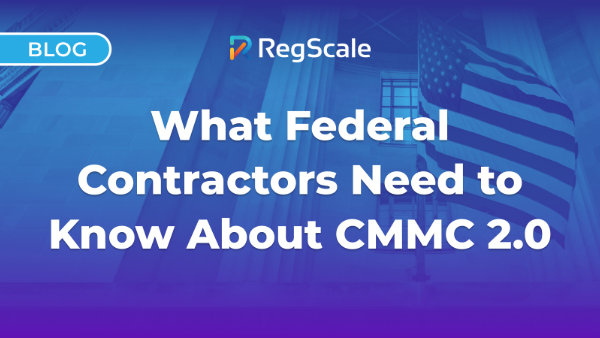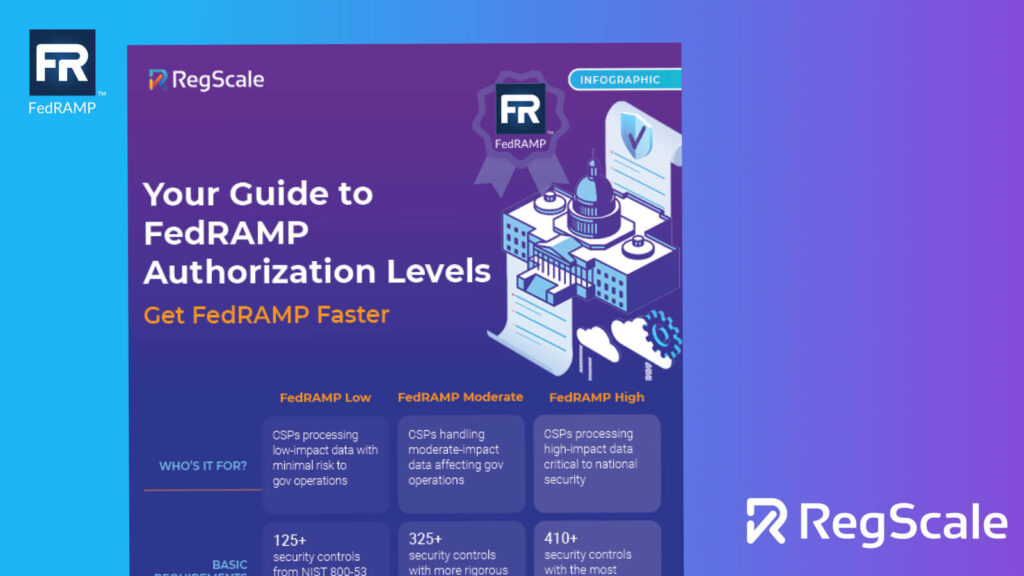
If you’re a federal contractor working with the Department of Defense, you’ve probably heard the acronym CMMC floating around — and for good reason. The Cybersecurity Maturity Model Certification (CMMC) is the DoD’s comprehensive framework designed to maintain national security and protect sensitive information flowing through the defense industrial base.
Think of CMMC as a cybersecurity report card for defense contractors. Just like how you might check a restaurant’s health inspection grade before dining there, the Department of Defense wants to know how well you’re protecting their sensitive data before they award you a contract.
In the past, we’ve provided a general overview of CMMC and its requirements. Today, we’ll dive into the more recent updates of CMMC 2.0, compare them to the earlier CMMC 1.0 model, and unpack everything that federal contractors need to know.
What does CMMC involve?
First, a quick refresher on the basics of the Cybersecurity Maturity Model Certification.
At its core, CMMC exists to safeguard two critical types of information: Federal Contract Information (FCI) and Controlled Unclassified Information (CUI). FCI includes things like basic contract details and similar data that’s not meant for public consumption. CUI is sensitive information that, while not classified, could still cause significant harm if it fell into the wrong hands.
The defense contractors and subcontractors who handle this government information are collectively known as the defense industrial base (DIB). The DIB includes everyone from major prime contractors building fighter jets to small suppliers providing specialized components. Unfortunately, this interconnected supply chain has become an attractive target for cyber adversaries looking to steal sensitive defense information.
That’s where CMMC comes in. Rather than simply trusting contractors to self-report their cybersecurity practices, the CMMC program requires third-party verification of security controls. It’s built on established cybersecurity standards like NIST SP 800-171, NIST SP 800-172, and FIPS 200, but it adds the crucial element of independent assessment and certification.
The CMMC framework also establishes different certification levels based on the sensitivity of the information being handled and the cybersecurity requirements needed to protect it. Each level builds upon the previous one, creating a tiered approach to cybersecurity maturity. This means that a contractor handling basic federal contract information will have different requirements than one dealing with highly sensitive CUI.
What makes CMMC 2.0 particularly significant is that it will eventually become a requirement for all DoD contracts. Once it’s fully implemented, it will be a business imperative for anyone wanting to receive contract awards and work with the Department of Defense.
CMMC 2.0 is still moving through the rulemaking process. However, once Title 48 of the Code of Federal Regulations (48 CFR) is finalized in 2025, a three-year implementation timeline with a phased rollout will kick off. Full implementation is expected in 2028.
How is CMMC 2.0 different from CMMC 1.0?
When the Department of Defense first introduced CMMC in 2020, it was ambitious — maybe a little too ambitious. The original CMMC 1.0 framework had five certification levels and required third-party assessments for nearly all contractors. While well-intentioned, the program faced significant industry pushback because of its complexity, cost, and implementation timeline.
As a result, CMMC 2.0 was announced in November 2021 to offer a more pragmatic approach. (Think of it as CMMC 1.0’s more streamlined, business-friendly sibling.) Below are a few of the crucial differences between the two versions.
Fewer levels, more focus
The most obvious change is the reduction from five CMMC 1.0 levels to just three CMMC 2.0 levels. This simplification makes it much easier for contractors to understand where they fit and what they need to achieve.
- CMMC Level 1 focuses on basic safeguarding of FCI
- CMMC Level 2 focuses on protecting CUI
- CMMC Level 3 handles the most sensitive CUI requiring the most advanced security measures
Self-assessment gets a bigger role
CMMC 2.0 is also more practical in its assessments. Instead of requiring expensive third-party assessments for everyone, the updated CMMC now allows Level 1 contractors to simply complete an annual self-assessment. This dramatically reduces the costs and administrative burden for smaller contractors who handle basic federal contract information.
Level 2 contractors (who make up the majority of the defense industrial base) will still need third-party certification assessments, but that process has been streamlined, too. Only Level 3 contractors (handling the most sensitive information) need to undergo the most rigorous government-led assessments.
Better alignment with existing standards
While CMMC 1.0 created some confusion about how it related to existing cybersecurity requirements, CMMC 2.0 provides clearer alignment with established frameworks like NIST 800-171 from the National Institute of Standards. This means that contractors who have already invested in compliance with current DFARS cybersecurity requirements won’t have to start from scratch.
Plan of Action and Milestones (POA&M) flexibility
One of the most contractor-friendly changes in CMMC 2.0 is the acceptance of Plans of Action and Milestones for certain security control gaps. This means that contractors don’t need to achieve perfect compliance before certification; instead, they can demonstrate a clear plan for addressing deficiencies within a reasonable timeframe.
Overall, CMMC 2.0 represents a more balanced approach that maintains strong cybersecurity standards while acknowledging the practical realities of implementation across the diverse defense industrial base. It’s still rigorous, but it’s also more achievable for contractors of all sizes.
Top things federal contractors need to know about CMMC 2.0
Ready or not — CMMC 2.0 is coming. 48 CFR, also known as the CMMC final rule, is moving through the rulemaking process and expected to be finalized in the coming months. Once that happens, CMMC requirements will begin taking effect.
Know your level. Determine whether you need Level 1, 2, or 3 certification based on the types of information you handle. Most contractors handling CUI will need Level 2, for instance.
Save money with self-assessment (if you qualify). Level 1 contractors can complete their own annual self-assessment instead of paying for third-party certification. This could save tens of thousands of dollars annually for eligible small businesses and subcontractors.
Third-party assessors are key. For Level 2 and 3, you’ll need a Certified Third-Party Assessment Organization (C3PAO) to conduct your CMMC assessment. Start planning your strategy with qualified assessors early.
POA&Ms give you breathing room. You don’t need perfect compliance on day one to win defense contracts. Plans of Action and Milestones allow you to demonstrate a clear remediation plan for addressing security control gaps while still achieving certification.
Prepare for supply chain impact. Prime contractors will require their subcontractors to have CMMC certification. If you’re a subcontractor, expect your primes to start asking about your CMMC status soon.
SPRS integration continues. The Supplier Performance Risk System will continue tracking contractor cybersecurity scores alongside CMMC certification status, so maintaining both remains important for DOD contractors.
Start your SSP now. Whether you’re preparing for self-assessment or third-party certification, having a comprehensive system security plan (SSP) and documented security controls will be essential for CMMC compliance.
Navigate CMMC 2.0 with 30% lower costs and faster timeline
CMMC 2.0 compliance doesn’t have to break the bank or consume all your resources. Smart contractors are finding ways to streamline the process and reduce costs.
RegScale’s Continuous Controls Monitoring platform streamlines your CMMC 2.0 program by automating documentation and evidence collection, significantly reducing the administrative burden, and improving accuracy. Our platform helps you identify and remediate security control gaps faster, provides continuous monitoring to maintain compliance between assessments.
The result? Cutting your CMMC certification costs by up to 30%.
Beyond CMMC compliance, RegScale supports multiple regulatory frameworks including FedRAMP and SOC 2, allowing defense contractors to address overlapping compliance requirements efficiently. With the help of our platform, organizations can transform their compliance challenges into opportunities for long-term resilience and success.
Ready to get started?
Choose the path that is right for you!
Skip the line
My organization doesn’t have GRC tools yet and I am ready to start automating my compliance with continuous monitoring pipelines now.
Supercharge
My organization already has legacy compliance software, but I want to automate many of the manual processes that feed it.
